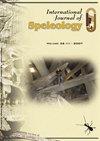Algae and cyanobacteria in the aphotic habitats of Veternica Cave (Medvednica Mt., Croatia) and selected caves of the Dinaric karst (South-Eastern Europe)
IF 1.3
4区 地球科学
Q3 GEOSCIENCES, MULTIDISCIPLINARY
引用次数: 1
Abstract
Microphototrophs (algae and cyanobacteria) in karst environments have been intensively studied in aquatic epigean habitats. In recent decades knowledge about the communities inhabiting cave entrances and lampenflora has grown substantially, but the data about the communities in aphotic cave zone are scarce. This study aimed to investigate spatio-temporal presence of microphototrophs in the aphotic zone of Veternica Cave (Mt. Medvednica karst) and to present additional preliminary data from 22 caves of the Dinaric karst. The data were collected over ten years, in parallel with research on cave phagotrophic protists. In addition to the remains of microphototrophs, living algae and cyanobacteria were found in the cave aphotic zone. Diatoms (Bacillariophyta) were the most frequent group found, followed by green algae (Chlorophyta), golden-brown algae (Chrysophyta) and the filamentous cyanobacteria (Cyanobacteria). The presence of microphototrophs was detected throughout the year but showed spatio-temporal variations. Microphototrophs were absent in the parts of Veternica Cave with seeping and dripping water, while they were occasionally present in the hydrologically active parts of the cave. The presence of diatoms in the aphotic zone of Veternica Cave was related to hydrological conditions, and was not affected by the distance from the cave entrance. The presence of microphototrophs in caves of the Dinaric karst has been associated with caves subject to various types of flooding by endogenous and exogenous water. Despite the fact that microphototrophs are passively transported to the caves from the surface habitats, the presence of live individuals in the cave aphotic zone implies that they should not be neglected in discussions about cave food webs. Future research of microphototrophs should be focused on the species identification, their abundance, survival time, and detail description of conditions that determine their presence in caves.Veternica洞穴(Medvednica Mt.,克罗地亚)和Dinaric喀斯特选定洞穴(东南欧)的无光栖息地中的藻类和蓝藻
岩溶环境中的微光营养物(藻类和蓝藻)已在水生表观生物栖息地进行了深入研究。近几十年来,人们对洞穴入口和七兰草群落的了解有了很大的增长,但对无虫洞穴区群落的了解却很少。本研究旨在调查Veternica洞穴(Mt.Medvednica喀斯特)无光区中微营养物的时空存在,并提供来自Dinaric喀斯特22个洞穴的额外初步数据。这些数据是在对洞穴自噬性原生生物进行研究的同时收集的,历时十年。除了微小营养体的遗迹外,在洞穴的无光区还发现了活的藻类和蓝藻。硅藻(硅藻门)是最常见的类群,其次是绿藻(绿藻门)、金褐藻(金藻门)和丝状蓝藻(蓝藻门)。全年都检测到微营养细胞的存在,但表现出时空变化。Veternica洞穴渗水和滴水的部分不存在微光营养物,而洞穴的水文活动部分偶尔也会出现微光营养物质。Veternica洞穴无光区硅藻的存在与水文条件有关,不受洞穴入口距离的影响。Dinaric岩溶洞穴中微营养物质的存在与受到内源性和外源性水的各种类型淹没的洞穴有关。尽管微小营养物是被动地从地表栖息地运输到洞穴的,但洞穴无光区中活体的存在意味着在关于洞穴食物网的讨论中不应忽视它们。未来对微营养体的研究应该集中在物种识别、它们的丰度、生存时间以及决定它们在洞穴中存在的条件的详细描述上。
本文章由计算机程序翻译,如有差异,请以英文原文为准。
求助全文
约1分钟内获得全文
求助全文
来源期刊

International Journal of Speleology
地学-地球科学综合
CiteScore
3.10
自引率
23.10%
发文量
12
审稿时长
>12 weeks
期刊介绍:
The International Journal of Speleology has the aim to get cave and karst science known to an increasing number of scientists and scholars. The journal therefore offers the opportunity to all scientists working in and on karst to publish their original research articles or their review papers in an open access, high quality peer reviewed scientific journal at no cost. The journal offers the authors online first, open access, a free PDF of their article, and a wide range of abstracting and indexing services.
 求助内容:
求助内容: 应助结果提醒方式:
应助结果提醒方式:


